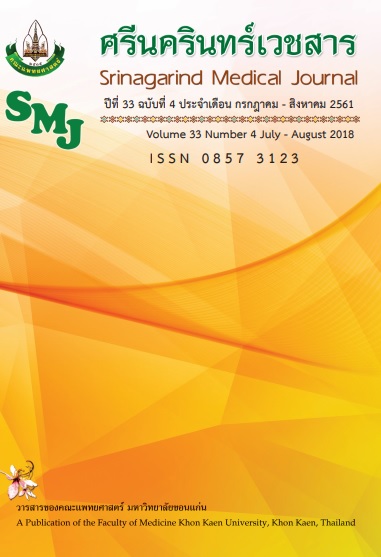ทัศนคติของผู้ป่วยนอก ต่อประโยชน์ของเอกสารกำกับยาสำหรับผู้ป่วย
คำสำคัญ:
ทัศนคติ; ใบปลิวข้อมูลผู้ป่วย; ชุดบรรจุ; ผู้ป่วยที่ป่วยเป็นโรคบทคัดย่อ
หลักการและวัตถุประสงค์ : เอกสารกำกับยาสำหรับผู้ป่วย (Patient information leaflet; PIL) เป็นแหล่งข้อมูลทางยาที่สำคัญสำหรับผู้ป่วย การให้ข้อมูลด้านยาที่ไม่เพียงพอสำหรับผู้ป่วยยังคงเป็นปัญหาในประเทศไทย การศึกษานี้มีวัตถุประสงค์เพื่อสำรวจทัศนคติของผู้ป่วยนอก ต่อประโยชน์ของ PIL และปัจจัยที่เกี่ยวข้อง
วิธีการศึกษา : เป็นการศึกษาแบบตัดขวาง เก็บข้อมูลที่โรงพยาบาลศรีนครินทร์และศูนย์หัวใจสิริกิติ์ฯ คณะแพทยศาสตร์ มหาวิทยาลัยขอนแก่น ระยะเวลา 3 เดือน กลุ่มตัวอย่าง 500 ราย คัดเลือกโดยการสุ่มอย่างเป็นระบบ เป็นผู้ป่วยนอก อายุ 18 ปีขึ้นไป แบบสอบถามแบ่งระดับความคิดเห็นเป็น 5 ระดับ และคะแนนทัศนคติรวม 3 ระดับ ต่ำ ปานกลาง และดี
ผลการศึกษา : ผู้เข้าร่วมการศึกษา 500 ราย เป็นเพศหญิง ร้อยละ 54.8 อายุเฉลี่ย 45.2 ± 14.04 ปี ผู้ป่วยร้อยละ 66.9 มีทัศนคติที่ดีต่อประโยชน์ของ PIL สำหรับคำถามเชิงบวก เห็นด้วยอย่างยิ่งว่าควรออกกฎหมายให้มีการจัดทำ PIL (ร้อยละ 50.7) PIL ช่วยให้ใช้ยาได้ถูกต้องมากขึ้น(ร้อยละ 49.9) PIL ช่วยให้ใช้ยาได้อย่างปลอดภัย (ร้อยละ 62.7) และควรมีออนไลน์ (ร้อยละ 60.9) สำหรับคำถามเชิงลบ ผู้ป่วยไม่เห็นด้วยอย่างยิ่งว่าพวกเขาไม่ต้องการคำแนะนำจากแพทย์หรือเภสัชกรหลังจากได้รับ PIL (ร้อยละ 41.9) ไม่เห็นด้วยว่า การอ่าน PIL ทำให้เสียเวลา (ร้อยละ 63.0) และทำให้ไม่มั่นใจในการใช้ยา (ร้อยละ 57.7) การวิเคราะห์หลายตัวแปรพบว่าผู้ป่วยที่ได้รับยาน้อยกว่า 2 ชนิด มีทัศนคติที่ดีกว่าอย่างมีนัยสำคัญทางสถิติ (OR 0.618, p = 0.024) และผู้ที่เคยได้รับเอกสารกำกับยา (Package insert ; PI) มีแนวโน้มทัศนคติที่ดีต่อการได้รับ PIL เช่นกัน (OR 1.971, p = 0.062)
สรุป : ผู้ป่วยนอกมีทัศนคติที่ดีต่อประโยชน์ของ PIL ดังนั้นบุคลากรทางการแพทย์ควรสนับสนุนและแนะนำกลยุทธ์ในการจัดหา PIL ที่ผู้ป่วยสามารถเข้าถึงได้อย่างกว้างขวาง
เอกสารอ้างอิง
2. Busapavanich S, Dandacha P. Unsuitable medication use behaviour of chronic kidney disease patients. Songkla Med J 2006; 24: 281-7.
3. Cullen G, Kelly E, Murray FE. Patients’ knowledge of adverse reactions to current medications. Br J Clin Pharmacol 2006; 62: 232-6.
4. Dickinson D, Raynor D.K, Duman M. Patient information leaflets for medicines: using consumer testing to determine the most effective design. Patient Educ Couns 2001; 43 :147-59.
5. Raynor DK, Knapp P. Do patient see, read and retain the new mandatory medicines information leaflets?. Pharm J 2000; 264: 260-70.
6. Koo MM, Krass I, Aslani P. Factor influencing consumer use of written drug information. Ann Pharmacother 2003; 37: 259-67.
7. Raynor DK, Savage I, Knapp P, Henley J. We are the experts: people with asthma talk about their medicine information needs. Patient Educ Couns, 2004; 53: 167-74
8. Aslani P, Hamrosi K, FelettoInvestigating E. Consumer Medicine Information (CMI) Report
(2010) CMI Effectiveness Tender. Canberra: The Pharmacy Guild of Australia and Department of Health and Ageing.
9. Gibbs S, Waters WE, George CF. The benefits of prescription information leaflets. Br J clin Pharmac, 1989; 27: 723-39.
10. Rajasundaram R, Phillips S, Clay RN. Information leaflet used in out‐patient clinics A survey of attitude and understanding of the user. IJHCQA 2006; 19: 575-9.
11. Hamrosi KK, Raynor DK, Aslani P. Pharmacist and general practitioner ambivalence about providing written medicine information to patients—A qualitative study. Res Social Adm Pharm 2013; 5; 517-30.
12. Pohjanoksa-Mäntylä M, Bell JS, Helakorpi S, Närhi U, Pelkonen A, Airaksinen MS. Is the Internet replacing health professionals? A population survey on sources of medicines information among people with mental disorders. Soc Psychiatry Psychiatr Epidemiol. 2011; 46: 373-9.
13. Raynor DK, Dickinson D. Key principles to guide development of consumer medicine information– content analysis of information design texts. Ann Pharmacother, 2009; 43: 700–6.
14. Moorthi C, Saravanakumar RT, Senthil Kumar C, Manavalan R, Kathiresan K. Systematic assessment of the quality of patient information leaflets supplied by the pharmaceutical manufacturers. Pharmacie Globale, 2012; 3: 1-3.
15. Dickinson R, Hamrosi K, Knapp P. Suits you? A qualitative study exploring preferences regarding the tailoring of consumer medicines information. Int J Pharm Pract 2013; 21: 207-15.
16. Hamrosi KK, Aslani P, Raynor DK. Beyond needs and expectations: identifying the barriers and facilitators to written medicine information provision and use in Australia. Health Expect 2014; 17: 220-31.




